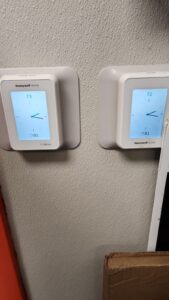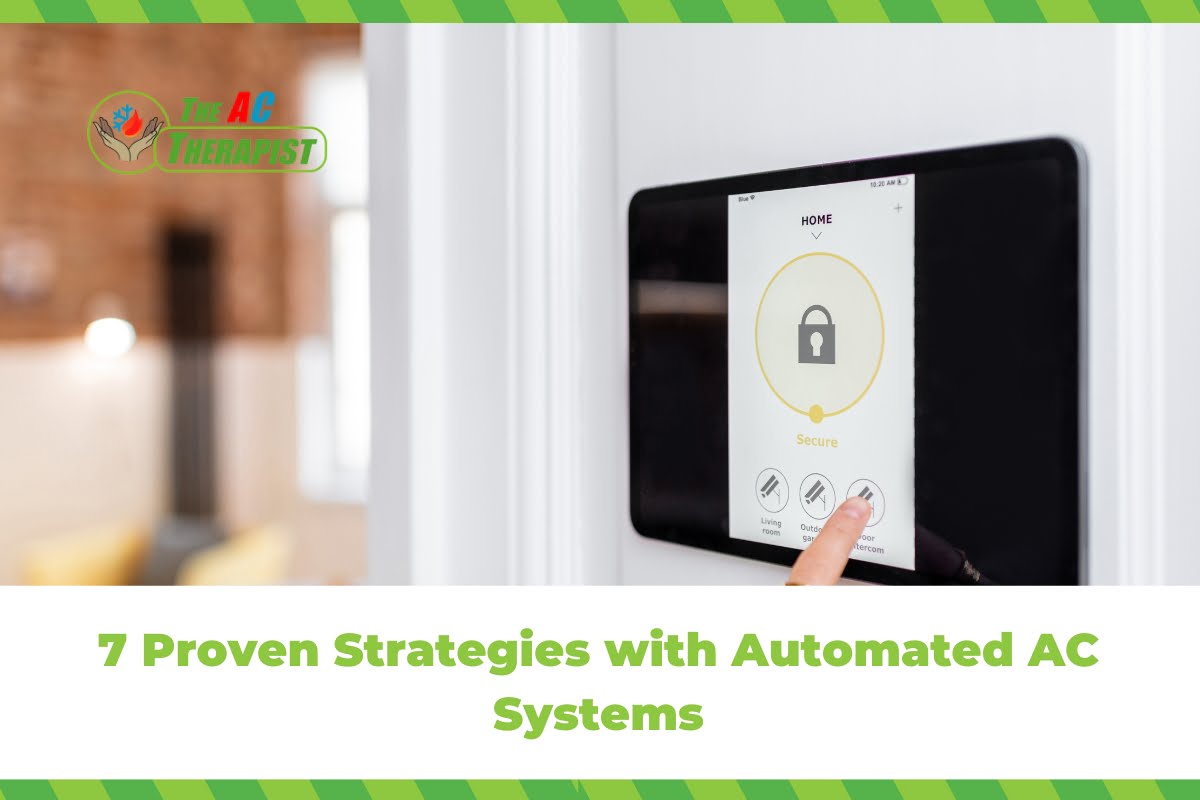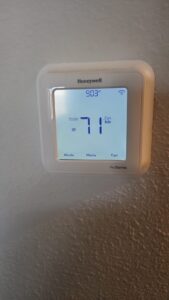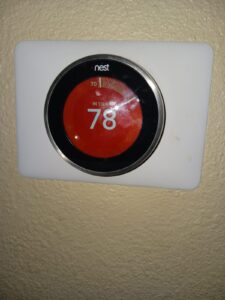7 Proven Strategies with Automated AC Systems
The evolution of air conditioning technology is a testament to human ingenuity and the relentless pursuit of comfort and efficiency. From the rudimentary ice and fan systems of ancient times to the sophisticated, energy-efficient models of today, air conditioning has come a long way. Initially designed for industrial purposes in the early 20th century, air conditioning soon became a staple in residential settings, transforming the way people lived and worked. The introduction of central air systems in the mid-20th century marked a significant leap forward, offering whole-house cooling that was previously unimaginable.
Today, we stand on the brink of another revolutionary shift with the advent of automated AC systems. These systems represent the pinnacle of convenience and efficiency, integrating advanced technologies to create a seamless, user-friendly experience. Automated AC systems go beyond mere temperature control; they learn from your habits, adjust to your preferences, and even anticipate your needs, all while optimizing energy use and reducing costs.
The significance of automated AC systems in modern living cannot be overstated. As we become increasingly conscious of our energy consumption and its impact on the planet, these smart systems offer a way to balance comfort with sustainability. They also cater to the growing demand for smart home technology, fitting seamlessly into ecosystems that include everything from smart lights to security systems, all controllable with a simple voice command or a tap on a smartphone.
The Rise of Automated AC Systems
The trajectory of air conditioning technology has been nothing short of remarkable, and at the forefront of this evolution is the rise of automated AC systems. These sophisticated systems have emerged as a pivotal innovation, setting new standards for comfort, efficiency, and convenience in our homes and workplaces. The journey from manual adjustments and simple thermostats to fully automated, smart climate control systems reflects a broader trend towards automation and smart technology in our daily lives.
Historical Context: From Manual ACs to the Dawn of Automation
The history of air conditioning technology began with manually operated systems that required constant attention to maintain desired temperatures. Early air conditioners were bulky, inefficient, and expensive, making them a luxury few could afford. As technology advanced, the introduction of the thermostat in the 20th century offered a more hands-off approach to temperature control, albeit with limited precision and flexibility.
The real transformation began with the digital age and the advent of programmable thermostats in the late 20th century. These devices allowed users to set temperature schedules, offering better control over their environment and energy consumption. However, it was the integration of internet connectivity and smart technology that marked the beginning of the automated AC system era.
The Technology Behind Automated AC Systems
Automated AC systems are built on a foundation of advanced technologies, including sensors, machine learning algorithms, and Internet of Things (IoT) connectivity. These components work in harmony to monitor and adjust the indoor climate without human intervention. Sensors placed throughout a space detect changes in temperature, humidity, and occupancy, feeding this data into a central control unit equipped with smart algorithms. This system can learn from your habits and preferences, adjusting the AC settings automatically to ensure optimal comfort and efficiency.
Key Players and Brands in the Automated AC Market
The rise of automated AC systems has been propelled by innovation from both established HVAC companies and new entrants focused on smart home technology. Brands like Honeywell, Nest (now part of Google), and Ecobee have led the charge, introducing smart thermostats that serve as the brains of automated AC systems. HVAC giants such as Carrier, Trane, and Daikin have also embraced automation, integrating smart controls into their air conditioning units to offer users unprecedented control over their indoor environment.
How Automated AC Systems Work
Automated AC systems represent a significant leap forward in home climate control technology, combining advanced sensors, smart thermostats, and Internet of Things (IoT) connectivity to create an intelligent, self-regulating environment. These systems are designed to optimize comfort and energy efficiency with minimal human intervention, relying on a complex network of components that work in harmony. Understanding how these systems function can shed light on their efficiency and the convenience they offer to users.
Components of an Automated AC System
- Sensors: These are the eyes and ears of an automated AC system. Placed strategically throughout a space, sensors monitor various environmental parameters such as temperature, humidity, and occupancy. Some systems may also include air quality sensors to detect levels of pollutants or allergens in the indoor air.
- Smart Thermostats: Serving as the brain of the system, smart thermostats process data collected by the sensors to make real-time decisions about heating and cooling settings. These devices can be programmed with user preferences and schedules but also can learn from user behavior over time, making automatic adjustments to improve comfort and efficiency.
- Controllers and Actuators: These components execute the commands from the smart thermostat, adjusting the operation of the AC unit itself. This can include turning the system on or off, modulating the cooling intensity, or adjusting the direction of airflow.
- Connectivity Modules: Automated AC systems are typically equipped with Wi-Fi or other wireless technologies that allow them to connect to the internet and integrate with a broader smart home ecosystem. This connectivity enables remote control via smartphones or tablets, voice control through smart speakers, and the ability to receive software updates that improve functionality over time.
The Role of IoT in Automation
The Internet of Things (IoT) is a critical enabler of automation in AC systems. By connecting smart thermostats and sensors to the internet, these systems can access external data such as weather forecasts to anticipate changes in environmental conditions and adjust settings accordingly. IoT connectivity also allows for remote monitoring and control, giving users the ability to manage their home climate from anywhere in the world.
Integration with Smart Home Ecosystems
Automated AC systems don’t operate in isolation; they are often part of a larger smart home ecosystem. This integration allows for coordinated control over multiple aspects of the home environment, from lighting and security systems to blinds and air purifiers. For instance, an automated AC system can work in tandem with smart blinds, closing them automatically on a hot day to reduce solar heat gain and minimize cooling needs.
The seamless operation of automated AC systems lies in the sophisticated interplay of these components. By leveraging advanced technologies and IoT connectivity, these systems offer a level of convenience, efficiency, and personalization that was unimaginable just a few decades ago. As technology continues to evolve, we can expect automated AC systems to become even smarter, further enhancing our living and working environments.
Benefits of Automated AC Systems
Automated AC systems, with their advanced technology and intelligent design, offer a plethora of benefits that go beyond mere temperature control. These systems are tailored to meet the growing demand for more efficient, convenient, and comfortable living environments. Here are some of the key benefits that automated AC systems bring to homes and commercial spaces.
Energy Efficiency
One of the most significant advantages of automated AC systems is their ability to reduce energy consumption. By precisely adjusting cooling based on real-time data from sensors and external factors like weather conditions, these systems ensure that air conditioning is only used when needed and at optimal levels. Smart thermostats can learn from your habits, automatically lowering the cooling when the house is empty and cooling down before you return. This targeted use of energy not only saves on utility bills but also contributes to a more sustainable lifestyle by reducing the carbon footprint associated with cooling needs.
Enhanced Comfort
Automated AC systems provide unparalleled comfort by maintaining a consistent indoor temperature tailored to personal preferences. Unlike traditional systems that might cool a space too much or too little, smart systems adjust dynamically, ensuring that every room in your home or office is kept at an ideal temperature. Moreover, some systems can create multiple climate zones within a single space, allowing different temperatures in different rooms to suit individual comfort levels.
Convenience and Control
The convenience offered by automated AC systems is unmatched. With remote access through smartphones, tablets, or voice commands via smart home assistants, users can control their AC systems from anywhere, at any time. Whether you’re lying in bed and want to adjust the temperature or you’re on your way home from work and wish to cool your house in advance, these systems provide total control at your fingertips. Scheduled adjustments and vacation modes further add to the convenience, ensuring that energy is not wasted on cooling an empty house.
Health and Air Quality
Automated AC systems can significantly improve indoor air quality by integrating with air purifiers and dehumidifiers. By monitoring air quality levels, these systems can automatically activate air purification or humidity control measures when needed, reducing the presence of allergens, dust, and other pollutants. This feature is particularly beneficial for individuals with allergies or respiratory issues, ensuring a healthier living environment.
Predictive Maintenance
Thanks to IoT connectivity and smart diagnostics, automated AC systems can predict and alert homeowners about maintenance needs before they escalate into major issues. This proactive approach to maintenance not only extends the lifespan of the AC unit but also ensures that it operates at peak efficiency, saving costs on emergency repairs and energy wastage due to inefficient operation.
Customization and Learning Capabilities
Automated AC systems can adapt to the unique needs of each household or commercial space. They learn from user behavior and adjust settings accordingly, ensuring optimal comfort and efficiency. Over time, these systems can identify patterns in your schedule and temperature preferences, automating adjustments so seamlessly that manual intervention becomes rarely necessary.
Choosing the Right Automated AC System
Choosing the right automated AC system for your home or business is a critical decision that can impact your comfort, energy consumption, and finances for years to come. With the myriad of options available on the market, it can be overwhelming to navigate the landscape of features, brands, and technologies. However, by considering a few key factors, you can make an informed choice that meets your specific needs.
1. Assess Your Space
The first step in selecting an automated AC system is to assess the size and layout of your space. The cooling capacity of an AC unit is measured in BTUs (British Thermal Units), and choosing a unit with the appropriate BTU rating is essential for efficient operation. A system that’s too large will cool quickly but inefficiently, leading to increased energy costs and humidity issues. Conversely, a system that’s too small will struggle to cool your space adequately, reducing comfort and overworking the unit. Professional HVAC contractors can perform a detailed load calculation to determine the optimal size for your system.
2. Consider Climate and Environment
Your local climate and environment play a significant role in determining the best automated AC system for your needs. If you live in an area with high humidity, look for systems with built-in dehumidification features. For those in hotter climates, systems with higher SEER (Seasonal Energy Efficiency Ratio) ratings will offer greater efficiency and cost savings in the long run. Additionally, consider the environmental impact of your choice by opting for systems that use eco-friendly refrigerants.
3. Energy Efficiency Ratings
Energy efficiency is a critical factor when selecting an automated AC system. Look for systems with high SEER and EER (Energy Efficiency Ratio) ratings, as these are more efficient and can significantly lower your energy bills. Modern automated systems often come with energy-saving features like programmable thermostats, variable speed fans, and smart sensors that further enhance efficiency.
4. Smart Features and Compatibility
The hallmark of an automated AC system is its smart features and compatibility with other smart home devices. Ensure that the system you choose can easily integrate with your existing smart home ecosystem, whether that’s through Wi-Fi connectivity, compatibility with smart home assistants (like Amazon Alexa or Google Assistant), or a dedicated app for remote control. Features such as voice commands, geofencing, and learning capabilities can provide unparalleled convenience and efficiency.
5. Installation and Maintenance
Proper installation and regular maintenance are key to the performance and longevity of your automated AC system. Choose a reputable HVAC contractor with experience in installing and servicing smart AC systems. Additionally, consider the system’s maintenance needs, including ease of access for filter changes and the availability of predictive maintenance alerts.
6. Cost vs. Value
While automated AC systems can be more expensive upfront than traditional units, it’s important to consider the long-term value they offer. The energy savings, enhanced comfort, and potential increase in property value can outweigh the initial investment over time. Look for rebates, tax credits, and financing options that can make the purchase more affordable.
7. Brand Reputation and Warranty
Finally, research the reputation of the brands you’re considering and the warranty coverage they offer. A strong warranty can provide peace of mind, covering parts and labor costs for repairs within the warranty period. Choose brands known for their quality, reliability, and customer service to ensure you’re investing in a system that will serve you well for years to come.
Installation and Maintenance Tips
Selecting the right automated AC system is just the beginning. Proper installation and regular maintenance are crucial for ensuring that your system operates efficiently and effectively over its lifespan. Here are some essential tips to help you with the installation and maintenance of your automated AC system.
Installation Tips
- Choose a Professional Installer: Always opt for a professional HVAC installer with experience in automated AC systems. They will ensure that your system is installed correctly, adhering to all safety standards and manufacturer guidelines. A professional installation is crucial for optimal performance and efficiency.
- Proper Sizing and Placement: As mentioned earlier, the correct size of your AC unit is vital. An experienced installer will perform a detailed load calculation to determine the appropriate size. Additionally, the placement of both indoor and outdoor units should be considered for maximum efficiency, avoiding areas with direct sunlight on the outdoor unit and ensuring adequate airflow around it.
- Ductwork Inspection and Upgrade: If your system requires ductwork, have it inspected and, if necessary, upgraded or repaired before installation. Leaky or inefficient ducts can significantly reduce system efficiency and comfort levels.
- Smart Thermostat Installation: Position your smart thermostat away from direct sunlight, drafts, doorways, windows, and furniture that can block airflow. It should be installed on an interior wall, centrally located to accurately read the average temperature of your home.
- System Compatibility Check: Ensure that all components of your automated AC system are compatible with each other and with your home’s existing smart devices. This includes the smart thermostat, sensors, and any other smart home integrations.
Maintenance Tips
- Regular Filter Changes: One of the simplest yet most effective maintenance tasks is regularly changing or cleaning the AC unit’s air filters. Dirty filters restrict airflow and reduce system efficiency, leading to higher energy bills and shorter equipment life. Check filters at least every 1-3 months, depending on use and environmental factors.
- Annual Professional Servicing: Schedule an annual service appointment with a professional HVAC technician. They will inspect your system, clean components, check refrigerant levels, and identify any potential issues before they become major problems.
- Keep Outdoor Unit Clear: Ensure the area around your outdoor unit is clear of debris, leaves, and vegetation. A clear space of at least 2 feet around the unit is recommended for optimal airflow and efficiency.
- Monitor System Performance: Pay attention to your automated AC system’s performance. If you notice unusual noises, smells, or a decline in cooling efficiency, contact a professional for inspection and repair.
- Software Updates: Keep your system’s software up to date. Manufacturers often release updates that improve performance, add new features, and fix bugs. Regular updates ensure your system operates at peak efficiency.
- Duct Cleaning and Inspection: Have your ductwork inspected and cleaned as needed to ensure efficient airflow and maintain indoor air quality. This is particularly important in systems that rely on ductwork to distribute cooled air throughout your home.

Unlocking Comfort and Efficiency: My Journey with Automated AC Systems
As The AC Therapist, I’ve witnessed firsthand the transformative impact that automated AC systems have on our homes and lives. Embracing these advanced systems has not only revolutionized the way we experience comfort but also redefined our approach to energy efficiency and smart living. Throughout this journey, we’ve explored the incredible benefits of automated AC systems, from their unparalleled energy efficiency to the enhanced comfort and convenience they offer. We’ve also navigated the critical steps of selecting the right system and ensuring its optimal installation and maintenance.
My mission has always been to help you create the most comfortable, healthy, and efficient living environments possible. With automated AC systems, I’ve seen the remarkable difference they make in achieving this goal. These systems are more than just a technological advancement; they are a lifestyle enhancement. They learn from us, adapt to our habits, and work tirelessly to maintain our ideal home climate, all while saving energy and reducing our environmental footprint.
I encourage you to consider the future of home climate control that automated AC systems represent. Whether you’re looking to upgrade your current system or install a new one, remember that the right choice can significantly improve your quality of life. The journey to a smarter, more comfortable home begins with a single step, and as your AC Therapist, I’m here to guide you every step of the way.
Embrace the change, invest in your comfort and efficiency, and let automated AC systems transform your home into the sanctuary it’s meant to be. Together, let’s unlock the full potential of your living spaces, making them smarter, more efficient, and infinitely more comfortable. Welcome to the future of home cooling, where automation meets personalization, and where every day is a perfect climate day.










